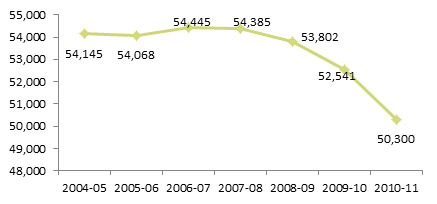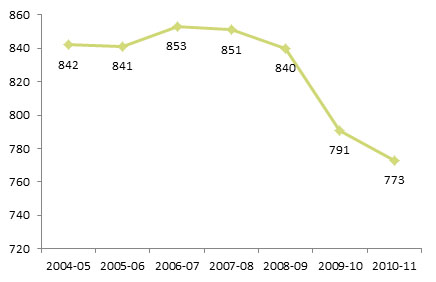As part of the Common Core of Data (CCD) program, the National Center for Education Statistics (NCES) releases a report each year on public elementary and secondary schools in the U.S. that includes staffing and student enrollment numbers.[note]All of the data reported in this Fast Facts are from the NCES report series “Public Elementary and Secondary School Student Enrollment and Staff Counts from the Common Core of Data,” which can be found at http://nces.ed.gov/ccd/pub_snf_report.asp.[/note] In 2004, these reports began providing the number of full-time-equivalent (FTE) public school librarians nationwide and for each state.
The definition of a “librarian” used by NCES is specific to the CCD collection, and is therefore the one that applies to the data presented in this Fast Facts. Notably, this definition does not include education or licensure requirements, i.e., a librarian does not necessarily have a master’s degree, a school library endorsement, or other library certification. The CCD defines a librarian or media specialist as:
A professional staff member or supervisor [as opposed to support staff] assigned specific duties and school time for professional library services activities. These include selecting, acquiring, preparing, cataloging, and circulating books and other printed materials; planning the use of the library by students, teachers, and instructional staff; and guiding individuals in the use of library books and materials maintained separately or as a part of an instructional materials center.
Librarians are categorized as “instructional and student support,” a group which also includes instructional aides, instructional coordinators and supervisors, guidance counselors/directors, other library support, and student support services staff. All together, this group represented 15 percent of public school FTEs in 2010-11.
The number of public school librarians (based on the definition above) nationwide in the 2010-11 school year according to NCES was 50,300, representing 0.8 percent of all FTE staff for public schools. The number of public school librarians in Colorado was 773, accounting for 0.7 percent of all Colorado FTE public school staff. (Not to be confused with the number of endorsed public school librarians, of which Colorado had 489 in 2010-11, based on Colorado Department of Education staffing data.)
Both the state and national numbers of school librarians have steadily declined since the 2007-08 school year, when the total number nationwide was 54,385 and Colorado’s number was 851. This decline marks a contrast from the relatively stable staffing period of 2004 to 2007. The exact figures for each year since 2004 are shown in Charts 1 and 2.
Chart 1
Total Public School Librarians
United States, 2004-2011 
Chart 2
Total Public School Librarians
Colorado, 2004-2011

While the number of librarians decreased from 2007 to 2011, the number of students in schools rose. From the 2007-08 to the 2010-11 school year, the total number of public school students increased by 2 percent nationwide (from 48,515,020 to 49,484,181), while the number of librarians decreased by 8 percent. In Colorado, the gap is more pronounced, as the total number of students rose by 5 percent over this 4-year period (from 801,867 to 843,316) while the number of school librarians fell by 9 percent.
This is a disturbing trend, as research over several decades has linked school librarians with student achievement. With fewer librarians employed in this sector—and more students—school librarians’ efforts will likely become diluted, thus limiting their ability to help students.
Additional information about school librarians’ impact on student achievement can be found on LRS’s School Library Impact Studies web page at http://www.lrs.org/impact.php, as well as in the Scholastic report School Libraries Work! (http://www.scholastic.com/content/collateral_resources/pdf/s/slw3_2008.pdf).